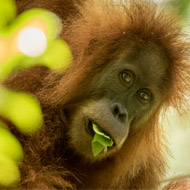
Less than 800 individuals remaining in the wild
A new species of orangutan has been discovered in Indonesia, according to researchers at the University of Zurich (UZH).
The species, Pongo tapanuliensis, was found in Batang Toru, North Sumatra. It is the third species to be recognised besides the Bornean and the Sumatran orangutan. But scientists warn that it is at the greatest risk of extinction.
A recent study carried out by the University of Zurich, together with a team of international researchers, revealed there are less than 800 individuals of the Tapanuli remaining in the wild.
“If steps are not taken quickly to reduce current and future threats and to conserve every last remaining bit of forest, a great ape species may become extinct within a few decades,” warns Matt Nowak, who supervises research into the Tapanuli orangutans at the Sumatran Orangutan Conservation Programme.
Researchers first realised that the Tapanuli population was unique when they compared the skull of a deceased adult male to other orangutan skulls. It turned out that certain characteristics of the teeth and skull of the Tapanuli orangutan were distinct.
Professor Michael Krutzen, who had been researching the genetic linege of all living orangutan populations for some time, said: “When we realized that the Tapanuli orangutans were morphologically different from all the other orangutans, the pieces of the puzzle fell into place."
The team constructed a computer model to verify their findings. Their calculations reveal that the Tapanli population appears to have been isolated from all other Sumatran population of orangutans for at least 10,000 to 20,000 years.
Alexander Nater, who completed his PhD at UZH, explained: “The oldest evolutionary line in the genus Pongo is actually found in Tapanuli orangutans, which appear to be direct descendants of the first Sumatran population in the Sunda archipelago."
Image (C) Maxinne Aliaga



 BSAVA is to partner with BVA Live (11-12 June 2026) to champion clinical research.
BSAVA is to partner with BVA Live (11-12 June 2026) to champion clinical research.